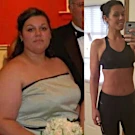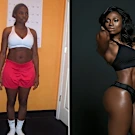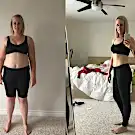What Is The Volumetrics Diet—And Can It Help You Lose Weight?
This diet is consistently ranked as one of the best weight-loss plans.

GETTY IMAGES
Just so you know: While Women's Health editors independently select all products we feature, product links may be from affiliate partners. That means if you buy something, Women's Health gets a portion of the proceeds.
And, yes, it centers on one fairly simple idea: filling up on fewer calories. “The main claim, and premise by which the Volumetrics diet works, is the satiety claim,” says Lisa Davis, Ph.D., chief nutrition officer at Terra’s Kitchen.
The primary focus is filling up on foods that are naturally low in calories and high in fiber or water—think fruits, veggies, and soups. “Since carbohydrates and proteins both provide four calories per gram, and fat provides nine calories per gram, you can eat more [carbs and protein] without the excess calories,” she explains, noting that people following the Volumetrics diet can expect to lose up to two pounds per week.
Of course, like most things in life, there’s more to the Volumetrics diet than meets the eye. We talked to a few registered dietitians to get the low-down on this eating approach.
The Volumetrics Diet Menu
If diets with strict rules and restrictions make you crazy, here's your reason to celebrate: You don't have to count calories, measure food, or log points on the diet. "Volumetrics is not a precisely prescribed diet plan, but rather a concept and overarching nutritional approach,” says Paul Salter, R.D., nutrition editor for Bodybuilding.com and founder of Fit In Your Dress.
On the Volumetrics diet, food is divided into four groups, he explains. Your goal: Eat mostly foods in groups one and two, be mindful of portion sizes of foods in group three, and minimize choices of foods from group four. And nothing is completely off-limits.
- Group one: non-starchy fruits and vegetables, nonfat milk and broth-based soup
- Group two: starchy fruits and veggies, grains, breakfast cereal, low-fat meat, legumes, low-fat mixed dishes like chili and spaghetti.
- Group three: meat, cheese, pizza, french fries, salad dressing, bread, pretzels, ice cream and cake.
- Group four: crackers, chips, chocolate candies, cookies, nuts, butter and oil.
Here's what you might eat in a typical day on the Volumetrics diet, according to Salter:
- Breakfast: Vegetable omelet with side of whole-wheat toast
- Morning Snack: Low-fat Greek yogurt with fruit
- Lunch: Lean meat chili with beans and vegetables
- Afternoon Snack: Air-popped popcorn (no butter) with glass of milk
- Dinner: A piece of fish, steamed veggies, qu
Does The Volumetrics Diet Really Work?
Of course, the million-dollar question: Is it legit? According to solid scientific research (including a 2016 meta-analysis of 13 studies that found a link between low-density foods and weight loss) and well, good old-fashioned common sense, it works. “One of the main reasons why people break their healthy eating is because they get hungry,” says Julie Upton, R.D., a registered dietitian and co-founder of Appetite for Health. Since you're still eating a high volume of food on the Volumetrics plan, you avoid those diet-busting hunger pains.
Hundreds of other nutrition studies back this up. In a 2007 study published in the American Journal of Clinical Nutrition, researchers randomly assigned 97 obese women to either a low-fat diet or a low-energy-dense, low-fat diet that emphasized fruits and vegetables. After a year, both groups lost weight, but the fruits-and-vegetables dieters lost even more—14 pounds compared with 11 pounds. The researchers deemed low-energy-dense diets an effective way to drop pounds and keep them off.
A 2005 study published in Obesity Research, co-authored by the Volumetrics diet creator, Rolls, suggests that a diet high in low-density foods and soup, a staple on the Volumetrics eating plan, leads to substantial weight loss. Another study of 186 women found decreasing energy density is a way to prevent weight gain and obesity in both the short and long term.
Another perk of the Volumetrics diet: “The majority of low-calorie, high-volume foods are nutrient-rich, and therefore positively impact your health in a variety of ways,” Salter says.
RELATED: 7 WOMEN SHARE HOW THEY LOST WEIGHT WITHOUT COUNTING A SINGLE CALORIE
Are There Any Disadvantages?
Now, if alarm bells are ringing in your head, you're not alone. As we've written about before, not all high-calorie foods are "bad" for you. In fact, plenty of foods that are high in calories and fat are essential for good health, such as nuts, seeds, avocado, and fatty fish.
One potential drawback to this diet is that it recommends a very low consumption of nuts and seeds (since they are calorically dense), Davis explains. "Nuts and seeds provide monounsaturated fats and omega-3 fatty acids; both beneficial for cardiovascular and cognitive health."
This is why almonds can help you lose weight:
Plus, like many diet plans, it can also be difficult to dine out on the Volumetrics diet, since so many restaurants and food services prepare their food with high-calorie, high-fat butters and oils, Davis points out. But no foods are 100 percent prohibited on this diet—it's more about putting the principles into practice.
Want to Get Started?
First, you'll want to check out Rolls' book, The Ultimate Volumetrics Diet. Then, you'll want to make meal prep your BFF. "Buy all of your produce and prep a lot of it over the weekend," Upton suggests. You'll also want to find some great soup recipes. "Broth-based soups are very low in energy density and if you eat them before a meal, they can help you eat less," she says.
"Planning out your meals for the week ahead of time will be crucial to your success," Salter adds. "Try to keep some high-volume, convenient foods handy too, such as fresh fruit and plenty of low-fat dairy. Once you return from grocery shopping, make food prep a priority so that there’s no thinking required at meal times—all you need to do is heat and eat!"
(Get the latest health, weight loss, fitness, and sex intel delivered straight to your inbox. Sign up for our "Daily Dose" newsletter.)
Finally, while it's not an essential component, the diet plan does encourage more movement throughout the day. There's no rigorous exercise program, but it does suggest simply increasing the amount of steps you take per day with the end goal of reaching around 10,000 steps, Davis says.
The bottom line? If the thought of prepping and eating more low-density foods, skipping calorie counts, and simply moving more sounds doable, you may be the perfect candidate to give the Volumetrics diet a try.






No comments:
Post a Comment